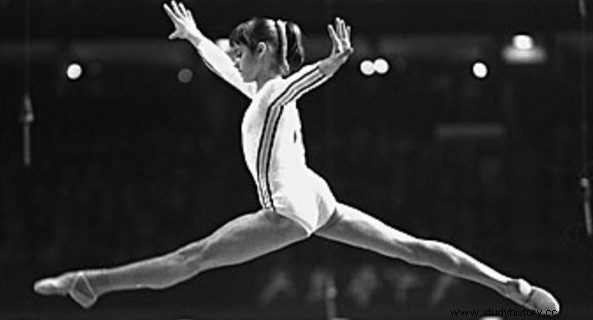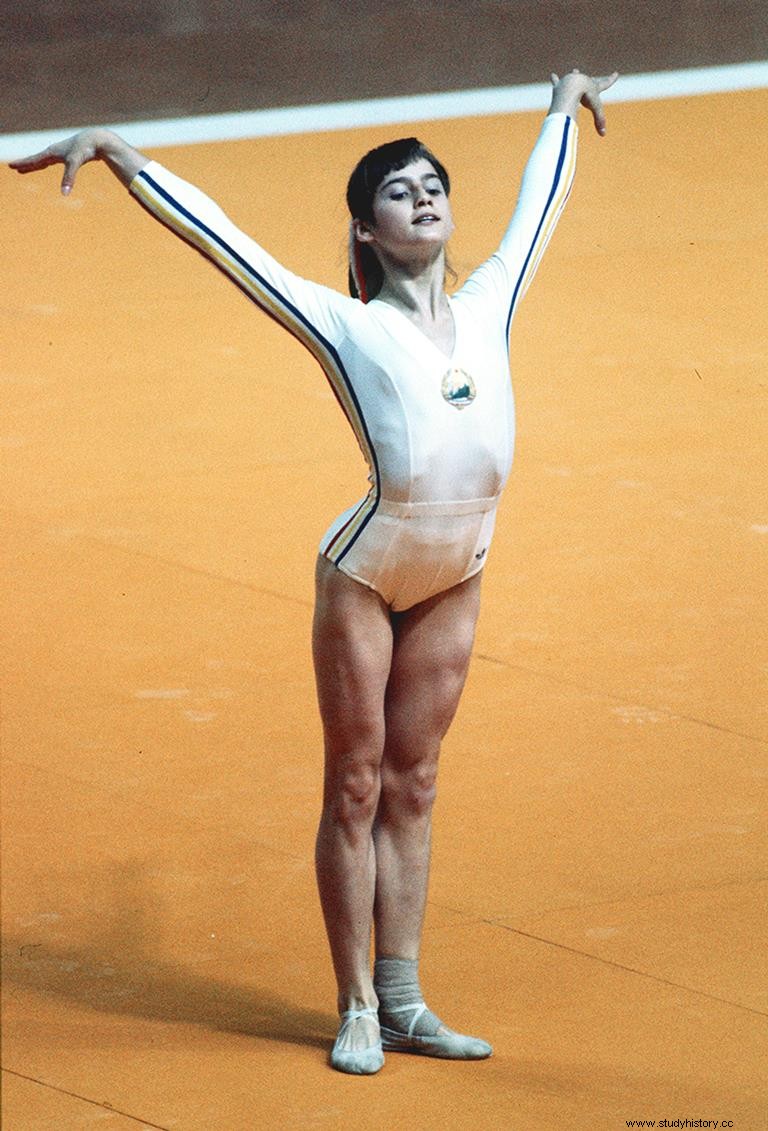Nadia Comăneci (born 1961) is a Romanian-American gymnast, considered one of the greatest gymnasts of all time. At 14, she became the first gymnast of all time to obtain a score of 10, rewarding a perfect performance, at the Olympic Games.
Gymnastics as a playground
Daughter of Stefania-Alexandrina and Gheorghe Comăneci, Nadia Elena Comăneci was born on November 12, 1961 in Onești, in the Romanian Carpathians, four years before dictator Nicolae Ceaușescu came to power. She has a younger brother, named Adrian.
Nadia begins to practice gymnastics in kindergarten. When she was six years old, the coaching couple Béla and Márta Károlyi visited her school. Béla asks the little girls if they can do a cartwheel; Nadia and one of her friends raise their hands. This meeting will really mark the beginning of his training as a gymnast. Managing the gymnastics school in Onesti, Béla and Márta train him daily. The little girl is delighted. Serious and reserved, she considers the gym and its equipment as a huge playground and is not afraid of anything. Eager to learn all the tricks, she works even harder than what is asked of her and quickly shows immense talent.

The youngest gymnast to win the national championship
In 1969, at the age of eight, Nadia Comăneci took part in the junior Romanian championships and finished 13th. Considering this result as a terrible failure, she redoubles her efforts to train. His days are divided into four hours of gymnastics and four hours of school, six days a week. The following year, she became the youngest gymnast to win the national championship. In 1971, Nadia won all the titles in her first international competition. In the years that followed, her success was undeniable:Nadia won national and international championships in Hungary, Poland and Italy. At 13, a senior, she won overall and on almost all apparatus at the 1975 European Gymnastics Championships in Norway. During her first tournaments, she already obtained the maximum mark of 10 several times for her performances on vault, on the floor or even on the uneven bars. Despite her youth, she is already gaining international recognition. In 1975, the United Press International awarded her the title of Best Athlete of the Year 1975.
The historic note at the Montreal Olympics
At 14, Nadia Comăneci took part in her first Olympic Games in Montreal in 1976. Younger than many of her competitors, she caused a sensation with her exceptional performance on the uneven bars, which allowed her to become the first gymnast to obtain the maximum score of 10. The feat was so unplanned that at the time, the scoreboards were not designed to record the score. During these Olympic Games, Nadia scored 10 seven times and won the gold medal in the all-around, on the uneven bars and on the beam, the team silver medal and the bronze medal on floor. Subsequently, Carol Anne Letheren, judge of the gymnastics events at the 1976 Olympics, declared that Nadia Comăneci's performance, her mastery and speed of execution of figures, had forced the judges to review their scoring system. If she had judged on the same scale as the others, she explains, Nadia should have received the mark of 12/10. Unthinkable and impossible.
An international star under the dictatorship
 Nadia Comăneci becomes an international star and receives numerous awards. In Romania, Nicolae Ceaușescu awards him the title of Hero of Socialist Labor . The dictatorship devotes a particular interest to the young athlete. The fate of the young girl, however, does not change and she knows the difficult living conditions of Romania under the dictatorship.
Nadia Comăneci becomes an international star and receives numerous awards. In Romania, Nicolae Ceaușescu awards him the title of Hero of Socialist Labor . The dictatorship devotes a particular interest to the young athlete. The fate of the young girl, however, does not change and she knows the difficult living conditions of Romania under the dictatorship.
In 1977, after Béla unknowingly received the son of Nicolae Ceaușescu badly, the Romanian Gymnastics Federation decided to separate Nadia from her coaches. The Hungarian origins of Béla would have displeased the dictator, preferring a Romanian coach. Nadia then leaves to train with Bucharest, with a much more flexible coach. As a teenager, she tasted freedom, going out, going to the cinema. This change in lifestyle, training, and the divorce of his parents put him through a difficult period. In 1978, Nadia was not in good physical condition for the world championships and her performances were disappointing compared to her past performances. After this relative failure, she was allowed to resume training with Béla and Márta.
In 1980, Nadia won several medals at the Moscow Olympics. Subsequently, she participated in a tour of gymnastics exhibitions in the United States . In Romania, the dictatorship is becoming more and more oppressive and living conditions are deteriorating; hunger, cold and shortages are rampant. Feeling threatened by the regime, Béla and Márta take advantage of their stay to flee and not return. On her return, Nadia is closely watched by the Securitate, the political police. Nicu Ceaușescu, son of Nicolae Ceaușescu, has a special interest in him. The two are often seen together and rumors are rife; the relationship is presumably imposed on the young woman. His life in Romania becomes hell.
The end of an exceptional career
In 1984, aged 24, Nadia Comăneci put an end to her career as a gymnast. Working at the Romanian Gymnastics Federation, she trains the next generation. In 1984, during the Olympic Games in Los Angeles, which she attended as a spectator, she tried to escape but was constantly watched. Thereafter, she is prohibited from leaving the territory. In November 1989, a few weeks before the revolution that would overthrow the Ceaușescu couple, she fled and joined the United States. There, she asks for asylum and confesses that she had been thinking about fleeing for several years.
In 1994, Nadia became engaged to American gymnast Bart Conner, whom she had met at the 1976 Olympics. They married two years later, in Bucharest, during Nadia's first trip to Romania since her exile; they will have a child in 2006. Active in several charitable organizations, she established a clinic for children in Bucharest as well as a gymnastics center. She is Honorary President of the Romanian Gymnastics Federation, Honorary President of the Romanian Olympic Committee, Sports Ambassador of Romania and member of the International Gymnastics Federation.
Many films, documentaries and writings are devoted to his journey, including the documentary "The gymnast and the dictator".
